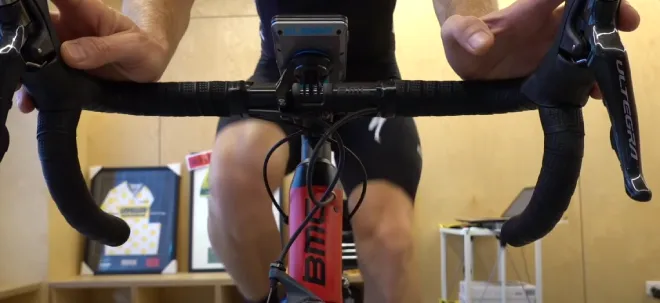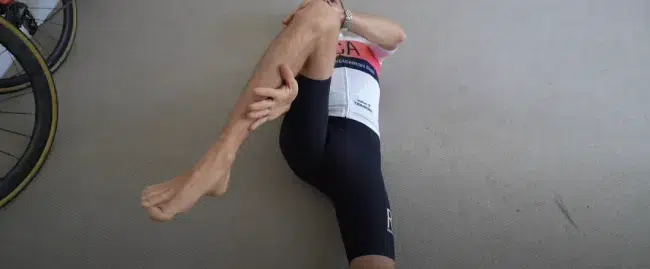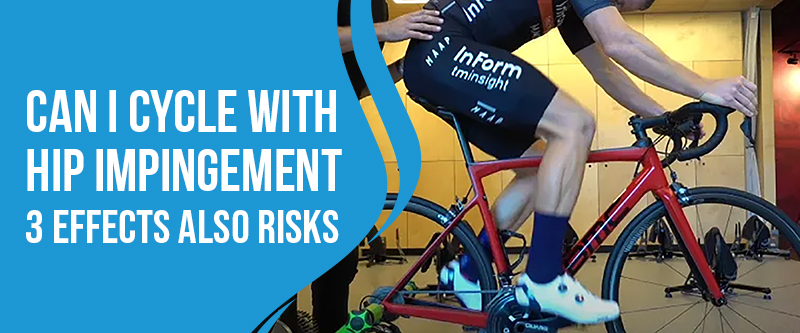Hip impingement usually causes pain or a pinching sensation in the front of the hip joint. Cycling athletes generally notice this at the top of the hip stroke (bringing the knee to the chin). It’s thought to develop from soft tissue pinching or bony compression in the hip joint.
Yes, you can cycle with hip impingement. It is recommended that you modify your training volume and intensity. Adjusting your bike fit can provide significant relief if your symptoms persist while cycling. Additionally, consider incorporating activities not involving full hip flexion, such as swimming.
We will explore how cycling can impact hip impingement, the factors to consider before cycling with this condition, and some valuable tips to help you cycle safely and effectively.
Can I Cycle with Hip Impingement: 3 Key Effects

While there are various treatments for hip impingement, cycling has been a topic of interest in recent years for its potential benefits. The effects of cycling on hip impingement will be discussed:
Benefits of Cycling on General Health
Cycling is a low-impact exercise that offers numerous benefits for your overall health and well-being. Some of the advantages of cycling include:
- Improved cardiovascular health.
- Increased muscle strength and endurance.
- Reduced stress and anxiety.
- Weight loss and management.
- Improved hip joint mobility.
Effectiveness of Cycling on Hip Impingement
Cycling can be an effective exercise option for individuals with hip impingement, but it’s crucial to approach it cautiously. Some ways in which cycling can be beneficial for hip impingement include:
- Cycling helps strengthen the flexor muscles around the hip joint, which can help support the joint and reduce pain.
- Cycling can also improve the range of hip motion, alleviating some stiffness and discomfort associated with hip impingement.
Risks of Cycling on Hip Impingement
While cycling can benefit individuals with hip impingement, there are also some risks to be aware of. These risks include.
Impact of Cycling on Hip Joint
Cycling can stress the hip joint, particularly if cycling at a high intensity or for long periods. This stress can exacerbate the symptoms of hip impingement and increase your risk of further damage to the joint.
Effects of Extreme Positions During Cycling
Extreme cycling positions and movements can also stress the hip joint. For example, cycling in a low aerodynamic position or in a position that requires your hips to rotate excessively can exacerbate symptoms of hip impingement.
Overuse Injuries
Overuse injuries can occur with any exercise, and cycling is no exception. Overuse injuries in the hip area can worsen hip impingement symptoms and may require rest and rehabilitation.
Cycling with Hip Impingement: Factors to Consider

While cycling can be low-impact, it can still stress the hip joint and worsen hip impingement symptoms. There are some things to consider before cycling with hip impingement.
Diagnosis and Severity of Hip Impingement
A femoral acetabular impingement (FAI) occurs when the bones in the hip joint grind against one another, causing pain and damage. The severity of hip impingement can vary, and there are three types of hip impingement:
- Cam impingement: When the femur ball is not round and does not fit properly into the hip socket.
- Pincer impingement: When the hip socket covers too much of the ball of the femur, causing pinching.
- Mixed impingement: A combination of both cam and pincer impingement.
Getting a proper diagnosis and understanding the severity of your hip impingement is essential before deciding whether or not to cycle. It’s best to ask your doctor or physical therapist for help.
Specific Type of Hip Impingement
The type of hip impingement you have can affect your ability to cycle. For example, those with cam impingement may be able to cycle with little to no pain, while those with pincer impingement may find it difficult to cycle due to the pinching sensation in their hip.
Personal Fitness Level
Personal fitness level is another crucial factor before cycling with hip impingement. If you’re not regularly active, cycling may be smooth and easy. Cycling may be a good exercise if you’re in good physical condition and have strong hip flexors.
Individual Limitations and Restrictions
It’s essential to consider your limitations and restrictions before cycling with hip impingement. Cycling may not be recommended if you have other health conditions or injuries. Additionally, certain types of cycling, such as mountain biking or long distance cycling, maybe more strenuous and cause more discomfort after hip replacement.
Cycling with Hip Impingement: Tips for Comfort and Safety
Hip impingement can make cycling a painful experience, but it doesn’t have to stop you from enjoying this activity. With the proper adjustments, gear, and exercises, you can reduce the discomfort and prevent further damage to your joints.Without proper technique and bike fit, cycling can also exacerbate front hip pain impingement. We’ll share some tips for cycling with hip impingement, from proper bike fit to overuse injury prevention.
Proper Bike Fit and Adjustments
How is your bike set up, which affects your comfort and performance? Here are some tips for an optimal bike fit for people with hip impingement:
- Position the saddle height and tilt correctly: Your saddle should be high enough for a full leg extension without hyperextension. During a cycling session, an incorrect saddle height can exacerbate hip flexor pain.
- Handlebar position: Position the handlebars to ensure a relaxing posture for your arms and shoulders. This optimal angle is key to preventing excessive pressure on your hips.
- Cleat position: Check the position of your cleats on your shoes. They should be positioned to allow a natural foot angle without excessive twisting or rotation.
Appropriate Cycling Gear
Wearing the right gear can also help prevent pain and discomfort while cycling. Here are a few things to consider:
- Quality cycling shorts: Shorts with padding can help reduce pressure and provide extra cushioning to your hips.
- Choosing the correct saddle: A saddle designed for cycling comfort will help distribute weight evenly and reduce pressure on the hips.
- Wearing clip-in shoes: Using clip-in shoes can help you maintain an efficient and consistent pedal stroke, which can reduce strain on the hips.
Warm-Up Exercises

Before starting your ride, it’s essential to warm up your hip and leg muscles. Here are some exercises for hip impingement that may help:
- Hip flexor stretch: This stretching exercise can help reduce tension in your hip flexor muscles. Simply kneel on one knee and lunge forward with the other leg, keeping your back straight.
- Foam rolling: Rolling out your thighs and hip muscles with a foam roller before your ride can help loosen any tightness or tension.
- Leg swings: Gently swinging your legs back and forth can help warm up the hip joint and prepare it for the ride.
Strengthening Exercises for Hip Joint
Strengthening your hip joint can help alleviate pain and discomfort while cycling. Here are some exercises to try:
- Clamshells: Lie on your side and lift your top leg, keeping your feet together. This exercise strengthens the hip abductor muscles.
- Leg lift: On your side, lift your top leg straight up, keeping it perfectly aligned with your hip. This exercise strengthens the hip flexor muscles.
- Squats: Squats can help strengthen the glutes, which help stabilize the hip joint. Make sure to use proper form and avoid overstraining the hips.
Tips to Prevent Overuse Injuries
Overuse injuries can occur when you cycle too often or for too long without proper recovery time. A few tips to avoid overuse injuries are as follows:
- Gradually increase cycling time and intensity: Increase your cycling routine gradually, giving your body time to build tolerance and avoid sudden spikes in activity.
- Take rest days: Make sure to give your hip and leg muscles recovery time between rides.
- Cross-train: Mix up your exercise routine by adding non-cycling activities, such as swimming or yoga, to help avoid overuse injuries.
Stationary Bike After Hip Replacement
Stationary biking provides a low-impact cardiovascular workout. Riding a stationary bike is good for reduce hip pain. Which means it puts minimal stress on your hips and other joints. This is crucial for managing hip impingement symptoms.
- Pain Management: Regular, gentle cycling can improve joint mobility and muscle strength around the hips, potentially reducing pain levels.
- Early Rehabilitation: Cycling on a stationary bike is often incorporated into early-stage rehabilitation programs following hip replacement surgery. It helps in regaining movement and strength.
- Speeds up Recovery: By promoting joint flexibility and building strength, stationary biking can speed up the healing process, getting you back to your daily activities sooner.
- Safe Exercise Option: Given the controlled environment of using a stationary bike, it poses less risk of falling or undue pressuring the new hip joint, making it a safer exercise option during recovery.
Conclusion
Cycling can be a great form of exercise for those with hip impingement. It relieves pain and stiffness while also improving overall fitness. Cycling can also have adverse effects if not done correctly, particularly if extreme positions are assumed, or overuse injuries occur.
Therefore, it is crucial to consider factors such as personal fitness level, diagnosis, and type of hip impingement before cycling. Seek professional guidance and follow the tips provided in this post to minimize the risk of injury.
Remember, the key to managing hip impingement is to stay active while avoiding aggravating activities, and cycling can be one fantastic way to achieve this.
FAQs
Which Exercises Are Avoided For Hip Impingement?
Avoiding activities involving extensive hip flexion with internal or external rotation is essential, as they can worsen the condition. Examples of practices to avoid include deep lunges, squats, high jumps, high knees, rowing, leg press, and squat jacks.
Which type of cycle is good for individuals with hip impairment?
For individuals with hip impingement, choosing the right type of cycle is crucial to minimize discomfort and maximize the benefits of cycling. Here’s a breakdown of suitable options:
Recumbent Bike: This type of bike features a reclined seating position with the legs extended in front. It’s gentle on the joints and offers excellent support for the back. Since there’s minimal pressure on the hips, it’s often comfortable for those with hip issues. However, recumbent bikes are pricier, heavier, and less portable than other types.
Upright Bike: Upright bikes are more traditional, with a seating position similar to regular bicycles. While they’re more affordable and easier to find than recumbent bikes, they may exert more pressure on the hips, especially if the saddle isn’t properly adjusted. Proper bike fit and adjustments can mitigate discomfort.
Stationary Bike: Stationary bikes come in both recumbent and upright designs. They offer the convenience of indoor use and adjustable resistance levels. While they provide a controlled environment for exercise, they may lack the real-world feel and variability of outdoor cycling. However, they’re generally safer and more accessible for those with mobility issues.
When selecting a cycle, it’s essential to prioritize comfort and proper bike fit. Adjustments such as saddle height, position, and handlebar placement can significantly impact hip stress. Consulting a bike fitter or physiotherapist for personalized guidance is advisable. Ultimately, the best choice depends on individual preferences, comfort, and fitness goals. Remember to listen to your body and avoid cycling if you experience pain or discomfort in the hip area. Cycling can benefit individuals with hip impingement when approached with caution and moderation.
How can I prevent or treat hip flexor strain from cycling?
Injuries to the hip flexors are common among cyclists and are caused by overuse or sudden hip joint movements. For prevention or treatment, try the following tips:
- Gear back and increase your cadence to take pressure off your hips.
- Raise your seat to reduce the amount of hip flexion and anterior impingement.
- Raise your handlebars so you sit a little more upright, relieving the amount of hip flexion.
- Stretch and strengthen your hip flexors regularly, using exercises such as lunges, bridges, and leg raises.
- Use a foam roller or massage to release tightness and tension in the gluteal and hip muscles.
- Be careful not to aggravate your pain by running, bending, or kicking.
- Rest and ice your hip if you feel acute pain or inflammation.
- Consult a doctor or physiotherapist if your pain persists or worsens or if you have other symptoms, such as snapping, clicking, or swelling in your hip.


